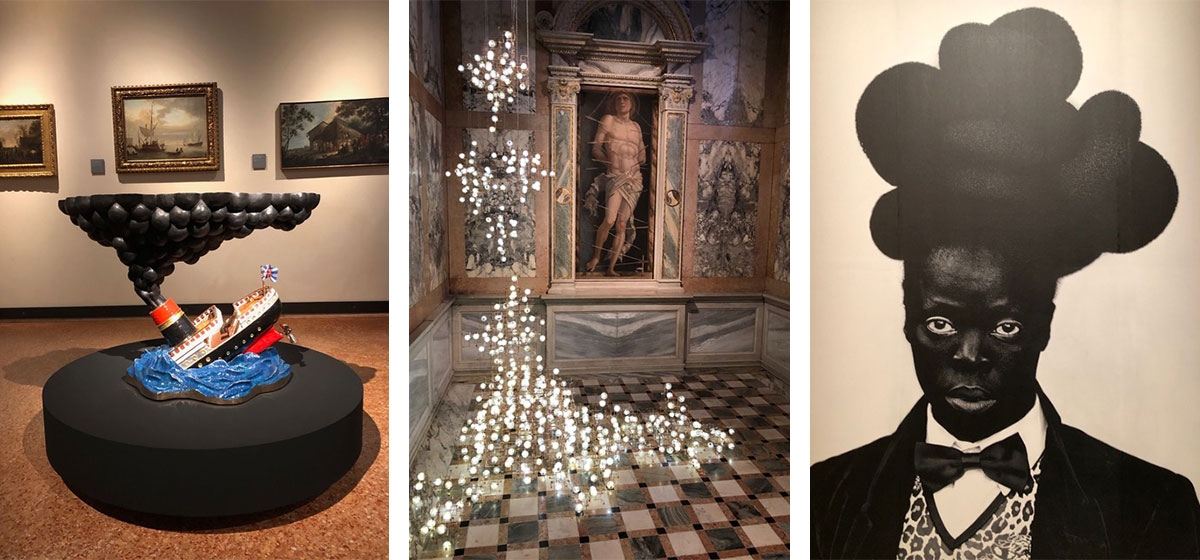“May We Live in Interesting Times”: The 58th Venice Biennale

I have just returned from my 10th (I think) Venice Biennale.
[ngg src=”galleries” ids=”321″ display=”basic_thumbnail” thumbnail_crop=”0″]
They tend to run together. Probably more than 1000 artists, 300 Aperol Spritzes, 150 Bellinis and 3,271 hors d’oeuvres. Princess Stephanie has blown smoke in my face from the terrace of the Peggy Guggenheim Museum. The Russians have come and gone. San Marco has been under water. The temperature has run from unbearably hot to cold and wet. From excursions on a friend’s little dinghy, ten-story tall cruise ships now grace the canal.
If one thing rings true over the decades, it is that Venice is a city of juxtapositions.
The theme for the 58th edition this year is “May we Live in Interesting Times.” While it is an ancient Chinese curse, previewing uncertainty, crisis and turmoil, it unfortunately couldn’t be more fitting today.
In this year’s exhibition there are a record 90 national pavilions spread between the Giardini, the Arsenale and various sites throughout the city. An additional 80 artists are curated into the thematic venue at both sites.
The Venice Biennale is particularly NOT an art dealer experience—no prices, no pressure, no competition to be the first to purchase like at Art Basel Miami. The art aficionados, dressed in various shades of black, surrounded by artists, journalists, curators and museum directors, reign supreme at private parties on sumptuous mega yachts or at the bars of the Bauer, Harry’s or the Cipprianni.
For the previews, the four days before the public is invited, thousands crowd the entrance to the French or the German or the Icelandic party, the Francois Pinault party, the Prada Foundation party and on and on. Only the “list-worthy” gain admittance. Women in elegant evening gowns wade through gaggles of fat tourists fresh off the cruise ships, or visitors from around the world following the raised umbrellas of the tour guides. Extravagant shoes and handbags clash with Nikes and plastic sacks filled with garish carnival masks, Murano glass globes and Venetian sailor caps.
I want to hate the fact that there are 358 visitors for every Venetian citizen, but I can’t. With my ‘cognisenti’ and press pass charm, I am welcomed beyond the barriers, into the sumptuous palazzos, the secret gardens, the finest private collections. That Venice was both the beginning and the end of the fabled Silk Road is lost on no one. Beauty and decadence reign supreme.
And then there is the art.
This is not an “I’d love to see that on my wall” type of show. The curator, Ralph Rugoff, has fought against that tooth and nail. He has chosen works that are not there to please us, but are there to make us think, engage us in encounters that are at once playful and serious, that leave us perplexed and smiling, disconcerted and confused, flummoxed and mystified. The curator speaks to “interconnectedness of diverse phenomena,” and mentions da Vinci and Lenin to prove his point that everything connects with everything else.
Art will not rid us of dictators or solve global warming or find a place for the endless garbage we create or the useless information with which we radiate our brains. The importance of the artwork will not be embedded in the artworks themselves, but in the conversations that follow between the artist and viewer and public.
A few highlights:
The United States Pavilion features Martin Puryear, an African American sculptor who confronts the very architecture of the Jeffersonian style building. In the central rotunda, his sculpture, a carved marble fluted column topped with a rusted iron stake from which a shackle hangs makes a not-to-subtle reference to the fact that Jefferson had five children with his slave Sally Hemmings. A black American with such gravitas juxtaposes greatly with Trump planning a speech in front of the Lincoln Memorial on the July 4th celebrations.
A Swiss artist, Christoph Buchel, arranged for the rusted fishing boat that sank off the Italian town of Lampedusa to be transported to the Arsenale. It sits there, with no signage, no explanation—at once both obscene and essential. In the hold, when the boat capsized, all but 27 of the 800 migrants drowned. What a surreal sight, next to the art lovers taking in the Biennale, the untold suffering and convoluted politics that continue to feed the plight of the underprivileged.
The Polish Pavilion exhibited a private jet turned inside out to reveal its complex guts as a juxtaposition to the mega yachts and plutocrats that haunt the Biennale.
The prize-winning Lithuanian pavilion, Sun and Sea (Marina) is a beach scene set indoors and viewed from above. Actors, performers and volunteers get up from their cell phones or newspapers as they bake under the artificial sun and sing various operatic songs. “The water blooms / Our bodies are covered with a slippery, green fleece / Our swimsuits are filling up with algae…” Is it about climate obsessions, a critique of leisure or just plain fun?
The Venezuelan pavilion was closed due to the potential revolution.
The French have a most intriguing video presentation by Laure Prouvost entitled “Deep See Blue Surrounding You.” After a long wait at the preview, we entered a basement door around the side of pavilion into a fantasy land of weird artifacts, debris including cigarette butts and discarded cell phones, and a hypnotized white dove. Her video documents a trip from Paris to Venice by her strangely chosen cast of characters that is more about their global reality than the destination.
It is impossible to put into words the experience that is the Venice Biennale. What I saw, along with 25,000 other curators, museum directors, collectors, artists and journalists during the previews was as varied as the weather we gallantly suffered: heat, rain, cold and fog. If, by chance, you happen to be in Venice before the exhibitions close on November 24, take in what you can. You won’t regret it.


